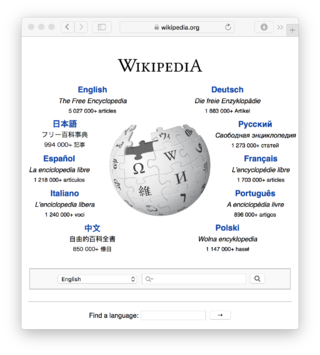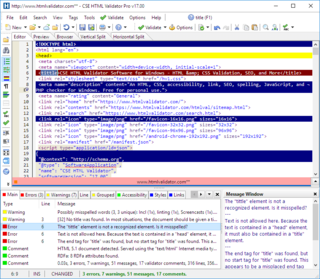
Java applets were small applications written in the Java programming language, or another programming language that compiles to Java bytecode, and delivered to users in the form of Java bytecode. The user launched the Java applet from a web page, and the applet was then executed within a Java virtual machine (JVM) in a process separate from the web browser itself. A Java applet could appear in a frame of the web page, a new application window, a program from Sun called appletviewer, or a stand-alone tool for testing applets.

Wiki software is collaborative software that runs a wiki, which allows the users to create and collaboratively edit pages or entries via a web browser. A wiki system is usually a web application that runs on one or more web servers. The content, including previous revisions, is usually stored in either a file system or a database. Wikis are a type of web content management system, and the most commonly supported off-the-shelf software that web hosting facilities offer.
Windows Management Instrumentation (WMI) consists of a set of extensions to the Windows Driver Model that provides an operating system interface through which instrumented components provide information and notification. WMI is Microsoft's implementation of the Web-Based Enterprise Management (WBEM) and Common Information Model (CIM) standards from the Distributed Management Task Force (DMTF).
Extensible Application Markup Language is a declarative XML-based language developed by Microsoft for initializing structured values and objects. It is available under Microsoft's Open Specification Promise.

Web conferencing is used as an umbrella term for various types of online conferencing and collaborative services including webinars, webcasts, and web meetings. Sometimes it may be used also in the more narrow sense of the peer-level web meeting context, in an attempt to disambiguate it from the other types known as collaborative sessions. The terminology related to these technologies is exact and agreed relying on the standards for web conferencing but specific organizations practices in usage exist to provide also term usage reference.
Enterprise content management (ECM) extends the concept of content management by adding a timeline for each content item and, possibly, enforcing processes for its creation, approval, and distribution. Systems using ECM generally provide a secure repository for managed items, analog or digital. They also include one methods for importing content to bring manage new items, and several presentation methods to make items available for use. Although ECM content may be protected by digital rights management (DRM), it is not required. ECM is distinguished from general content management by its cognizance of the processes and procedures of the enterprise for which it is created.
Microsoft WinHelp is a proprietary format for online help files that can be displayed by the Microsoft Help browser winhelp.exe or winhlp32.exe. The file format is based on Rich Text Format (RTF). It remained a popular Help platform from Windows 3.0 through Windows XP. WinHelp was removed in Windows Vista purportedly to discourage software developers from using the obsolete format and encourage use of newer help formats. Support for WinHelp files would eventually be removed entirely in Windows 10.
Microsoft Assistance Markup Language is an XML-based markup language developed by the Microsoft User Assistance Platform team to provide user assistance for the Microsoft Windows Vista operating system. It makes up the Assistance Platform on Windows Vista.
ND-NOTIS was a office automation suite by Norsk Data introduced in the early 80s, running on the SINTRAN III platform on both ND-100 and ND-500 architectures. It was also available on Microsoft Windows running in networks of Norsk Data servers.
Sandcastle is a documentation generator from Microsoft. It automatically produces MSDN-style code documentation out of reflection information of .NET assemblies and XML documentation comments found in the source code of these assemblies. It can also be used to produce user documentation from Microsoft Assistance Markup Language (MAML) with the same look and feel as reference documentation.

Quick Assist is a Microsoft Windows feature that allows a user to view or control a remote Windows computer over a network or the Internet to resolve issues without directly touching the unit. It is based on the Remote Desktop Protocol (RDP). It is complemented by Get Help, a feature introduced in Windows 10 that enables the user to contact Microsoft directly but does not allow for remote desktoping or screen sharing.
Comparison of the Java and .NET platforms.
Microsoft Help 2.x is a proprietary format for online help files, developed by Microsoft and first released in 2001 as a help system for Visual Studio .NET (2002) and MSDN Library.
Biblical software or Bible software is a group of computer applications designed to read, study and in some cases discuss biblical texts and concepts. Biblical software programs are similar to e-book readers in that they include digitally formatted books, may be used to display a wide variety of inspirational books and Bibles, and can be used on portable computers. However, biblical software is geared more toward word and phrase searches, accessing study bible notes and commentaries, referencing various modern translations, cross-referencing similar passages and topics, biblical dictionaries, original language texts and language tools, maps, charts, and other e-books deemed relevant to understanding texts from a philological approach.
Trados Studio is a computer-assisted translation software tool which offers a complete, centralized translation environment for editing, reviewing and managing translation projects and terminology. It is available both as a local desktop tool or online. Trados, owned by RWS, also provides a suite of intelligent machine translation products.

CSS HTML Validator is an HTML editor and CSS editor for Windows that helps web developers create syntactically correct and accessible HTML/HTML5, XHTML, and CSS documents by locating errors, potential problems like browser compatibility issues, and common mistakes. It is also able to check links, check spelling, suggest improvements, alert developers to deprecated, obsolete, or proprietary tags, attributes, and CSS properties, and find issues that can affect search engine optimization.
OpenSearchServer is an open-source application server allowing development of index-based applications such as search engines. Available since April 2009 on SourceForge for download, OpenSearchServer was developed under the GPL v3 license and offers a series of full text lexical analyzers. It can be installed on different platforms.
Blackbird was the codename for an online content authoring platform developed by Microsoft in the mid-90s. Intended to be the online publishing tool for the first version of MSN, "Blackbird" was born of a Microsoft acquisition of Daily Planet Software, and the tool was first conceived prior to the advent of the Internet and Web as we know it today. At the time, AOL and CompuServe were the primary online venues, and the introduction of the Web to mass consumers was about to begin, even as low-bandwidth, dialup connections dominated. "Blackbird" was based on the concept of an object-based backend file system in Microsoft Data Centers, a low-bandwidth-streaming rendering client with page-based layout and embedded interactive client-side ActiveX objects. Fundamentally, it was based on the SGML standard for client-side layout. It became a Microsoft-promoted alternative to HTML for a brief time, just as the commercial Internet and Web Browser were born. But with scripting capability for HTML yet to be demonstrated, it was to be a means to serve dynamic, media-rich applications and documents that contained processing logic, similar to what a user would experience in a desktop environment. Pages in a "Blackbird application" would be able to contain video, audio, graphs, and other OLE based document formats without the need of plug-ins.




